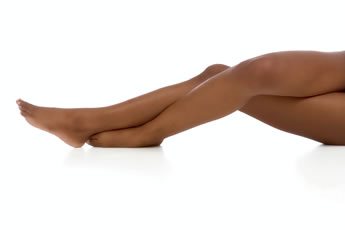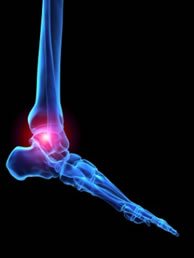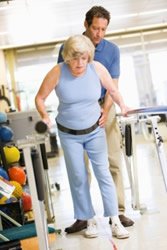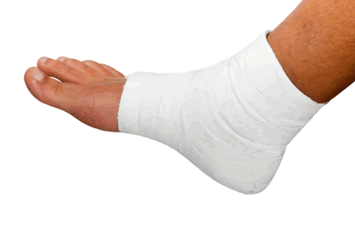January 2016
Facts About Corns
 Dr. Parichart Vaikayee, DPM, dispels five commonly thought myths about foot injuries. One particular issue that she highlights is corns. Corns form as a result of a hammertoe, when the toe bone protrudes and rubs against surfaces. This leads to the build-up of skin, or corns. Corns are different than calluses, and can’t be eliminated through at-home treatment. Corn removal requires surgical care and should not be attempted by yourself.
Dr. Parichart Vaikayee, DPM, dispels five commonly thought myths about foot injuries. One particular issue that she highlights is corns. Corns form as a result of a hammertoe, when the toe bone protrudes and rubs against surfaces. This leads to the build-up of skin, or corns. Corns are different than calluses, and can’t be eliminated through at-home treatment. Corn removal requires surgical care and should not be attempted by yourself.
If you have any concerns about your feet and ankles contact one of our podiatrists of University Foot and Ankle Center, L.L.C. Our doctors will treat your foot and ankle needs.
Corns: What are they? And how do you get rid of them?
Corns can be described as areas of the skin that have thickened to the point of becoming painful or irritating. They are often layers and layers of the skin that have become dry and rough, and are normally smaller than calluses.
Ways to Prevent Corns
There are many ways to get rid of painful corns such as wearing:
- Well-fitting socks
- Comfortable shoes that are not tight around your foot
- Shoes that offer support
Treating Corns
Treatment of corns involves removing the dead skin that has built up in the specific area of the foot. Salicylic acid can help in getting rid of these corns because it dissolves keratin, which is the protein that makes up a good majority of corns. Podiatrists recommend that people with diabetes not use salicylic acid but should consult with their podiatrist regarding the treatment of corns.
If you have any questions please feel free to contact our offices located in East Brunswick and Monroe Township, NJ. We offer the newest diagnostic tools and technology to treat your foot and ankle needs.
“Biological Clocks” May Reduce Effects of Arthritis
 British researchers at Manchester University published their findings on arthritis in the Journal of Clinical Investigation. Their findings suggest that eating and exercising at a set time every day can help combat the effects of arthritis. This practice allegedly leads to small genes creating “biological clocks” in the body, which can help maintain healthy cartilage. Arthritis exists as a debilitating disease that leads to the wearing and tearing of cartilage of joints, which can affect overall mobility. Dr. Qing-Jung Meng, a biologist at Manchester University, found that these small body clocks encourage the mending of damaged cartilage and can be activated by continual daily exercise.
British researchers at Manchester University published their findings on arthritis in the Journal of Clinical Investigation. Their findings suggest that eating and exercising at a set time every day can help combat the effects of arthritis. This practice allegedly leads to small genes creating “biological clocks” in the body, which can help maintain healthy cartilage. Arthritis exists as a debilitating disease that leads to the wearing and tearing of cartilage of joints, which can affect overall mobility. Dr. Qing-Jung Meng, a biologist at Manchester University, found that these small body clocks encourage the mending of damaged cartilage and can be activated by continual daily exercise.
Arthritis can be a difficult condition to live with. If you have any concerns about your feet and ankles contact one of our podiatrists of University Foot and Ankle Center, L.L.C. Our doctors will treat your foot and ankle needs.
Arthritic Foot Care
Arthritis is a joint disorder that involves inflammation of different joints in your body, such as in your feet. Arthritis is often caused by a degenerative joint disease and causes mild to severe pain in all affected areas. On top of this, swelling and stiffness in the affected joints can also be a common symptom of arthritis.
In many cases, wearing ill-fitting shoes can worsen the effects and pain of arthritis. Wearing shoes that have a lower heel and extra room can help your feet feel more comfortable. In cases of rheumatoid arthritis, the arch in your foot may become problematic. Buying shoes with proper arch support that contour to your feet can help immensely.
Alleviating Arthritic Pain
- Exercises that stretch the foot can prevent further pain and injury and increase mobility
- Most of the pain can be alleviated with anti-inflammatory drugs, heat, and topical medications
- Massages can help to temporarily alleviate pain.
It is best to see your doctor for the treatment that is right for your needs and symptoms. Conditions vary, and a podiatrist can help you determine the right method of care for your feet.
If you have any questions please feel free to contact our offices located in East Brunswick and Monroe Township, NJ. We offer the newest diagnostic tools and technology to treat your foot and ankle needs.
Possible Link Between Slower Walking Speeds in Elderly and Alzheimer’s
 Walking at a slower speed than normal may be a symptom of Alzheimer’s. Although walking is considered a healthy exercise for everyone, those who are elderly and slowly may have symptoms associated with having increased amyloid amounts, an abnormal protein linked to Alzheimer’s disease. Research done in France suggests that there is a possible association “between slow walking speed and amyloid in several areas of the brain, including a region called the putamen.” Natalia del Campo, the study author at the Gerontopole and the Centre of Excellence in Neurodegeneration of Toulouse, says that “subtle walking disturbances” may be one attributable symptom linked to memory concerns.
Walking at a slower speed than normal may be a symptom of Alzheimer’s. Although walking is considered a healthy exercise for everyone, those who are elderly and slowly may have symptoms associated with having increased amyloid amounts, an abnormal protein linked to Alzheimer’s disease. Research done in France suggests that there is a possible association “between slow walking speed and amyloid in several areas of the brain, including a region called the putamen.” Natalia del Campo, the study author at the Gerontopole and the Centre of Excellence in Neurodegeneration of Toulouse, says that “subtle walking disturbances” may be one attributable symptom linked to memory concerns.
Proper foot care is something many older adults forget to consider. If you have any concerns about your feet and ankles contact one of our podiatrists of University Foot and Ankle Center, L.L.C. Our doctors will treat your foot and ankle needs.
The Elderly and their Feet
As we age we start to notice many changes in our body, but the elder population may not notice them right away. Medical conditions may prevent the elderly to take notice of their foot health right away. Poor vision is a lead contributor to not taking action for the elderly.
Common Conditions
Neuropathy – can reduce feeling in the feet, and can hide many life threating medical conditions.
Reduced flexibility – prevents the ability of proper toenail trimming, and foot cleaning. If left untreated, it may lead to further medical issues.
Foot sores – amongst the older population can be serious before they are discovered. Some of the problematic conditions they may face are:
Gouging toenails affecting nearby toe
Shoes that don’t fit properly
Pressure sores
Loss of circulation in legs & feet
Edema & swelling of feet and ankles
Susceptible Infections
Diabetes and poor circulation can cause general loss of sensitivity over the years, turning a simple cut into a serious issue.
If you have any questions please feel free to contact our offices located in East Brunswick and Monroe Township, NJ. We offer the newest diagnostic tools and technology to treat your foot and ankle needs.
Arkansas Razorbacks Defensive Lineman Breaks Foot
 Senior Mitchell Loewen, the Arkansas Razorbacks defensive lineman, suffered a broken foot injury and will be unable to play for the rest of the season. Loewen plans to undergo surgery and won’t be playing for the Razorbacks again. Arkansas coach Bret Bielema said that “Loewen is the 10th player to break a bone this year for Arkansas.” Loewen has played 10 games for the Razorbacks and was scouted by NFL teams during this season.
Senior Mitchell Loewen, the Arkansas Razorbacks defensive lineman, suffered a broken foot injury and will be unable to play for the rest of the season. Loewen plans to undergo surgery and won’t be playing for the Razorbacks again. Arkansas coach Bret Bielema said that “Loewen is the 10th player to break a bone this year for Arkansas.” Loewen has played 10 games for the Razorbacks and was scouted by NFL teams during this season.
A broken foot requires immediate medical attention and treatment. If you are having discomfort in your feet and would like to try orthotics, contact one of our podiatrists of University Foot and Ankle Center, L.L.C. Our doctors will treat your foot and ankle needs.
Broken Foot Causes, Symptoms, and Treatment
A broken foot is caused by one of the bones in the foot typically breaking when bended, crushed, or stretched beyond its natural capabilities. Usually the location of the fracture indicates how the break occurred, whether it was through an object, fall, or any other type of injury.
Common Symptoms of Broken Feet:
- Bruising
- Pain
- Redness
- Swelling
- Blue (foot)
- Numbness
- Cold
- Misshapen
- Cuts
- Deformities
Those that suspect they have a broken foot shoot seek urgent medical attention where a medical professional could diagnose the severity.
Treatment for broken bones varies depending on the cause, severity and location. Some will require the use of splints, casts or crutches while others could even involve surgery to repair the broken bones. Personal care includes the use of ice and keeping the foot stabilized and elevated.
If you have any questions please feel free to contact our offices located in East Brunswick and Monroe Township, NJ. We offer the newest diagnostic tools and technologies to treat your foot and ankle needs.
Blog Archives
- April 2024
- March 2024
- February 2024
- January 2024
- December 2023
- November 2023
- October 2023
- September 2023
- August 2023
- July 2023
- June 2023
- May 2023
- April 2023
- March 2023
- February 2023
- January 2023
- December 2022
- November 2022
- October 2022
- September 2022
- August 2022
- July 2022
- June 2022
- May 2022
- April 2022
- March 2022
- February 2022
- January 2022
- December 2021
- November 2021
- October 2021
- September 2021
- August 2021
- July 2021
- June 2021
- May 2021
- April 2021
- March 2021
- February 2021
- January 2021
- December 2020
- November 2020
- October 2020
- September 2020
- August 2020
- July 2020
- June 2020
- May 2020
- April 2020
- March 2020
- February 2020
- January 2020
- December 2019
- November 2019
- October 2019
- September 2019
- August 2019
- July 2019
- June 2019
- May 2019
- April 2019
- March 2019
- February 2019
- January 2019
- December 2018
- November 2018
- October 2018
- September 2018
- August 2018
- July 2018
- June 2018
- May 2018
- April 2018
- March 2018
- February 2018
- January 2018
- December 2017
- November 2017
- October 2017
- September 2017
- August 2017
- July 2017
- June 2017
- May 2017
- April 2017
- March 2017
- February 2017
- January 2017
- December 2016
- November 2016
- October 2016
- September 2016
- August 2016
- July 2016
- June 2016
- May 2016
- April 2016
- March 2016
- February 2016
- January 2016
- December 2015
- November 2015
- October 2015
- September 2015
- August 2015
- July 2015
- June 2015
- May 2015
- April 2015
- March 2015
- February 2015
- January 2015
- December 2014
- November 2014
- October 2014
- September 2014
- August 2014
- July 2014




